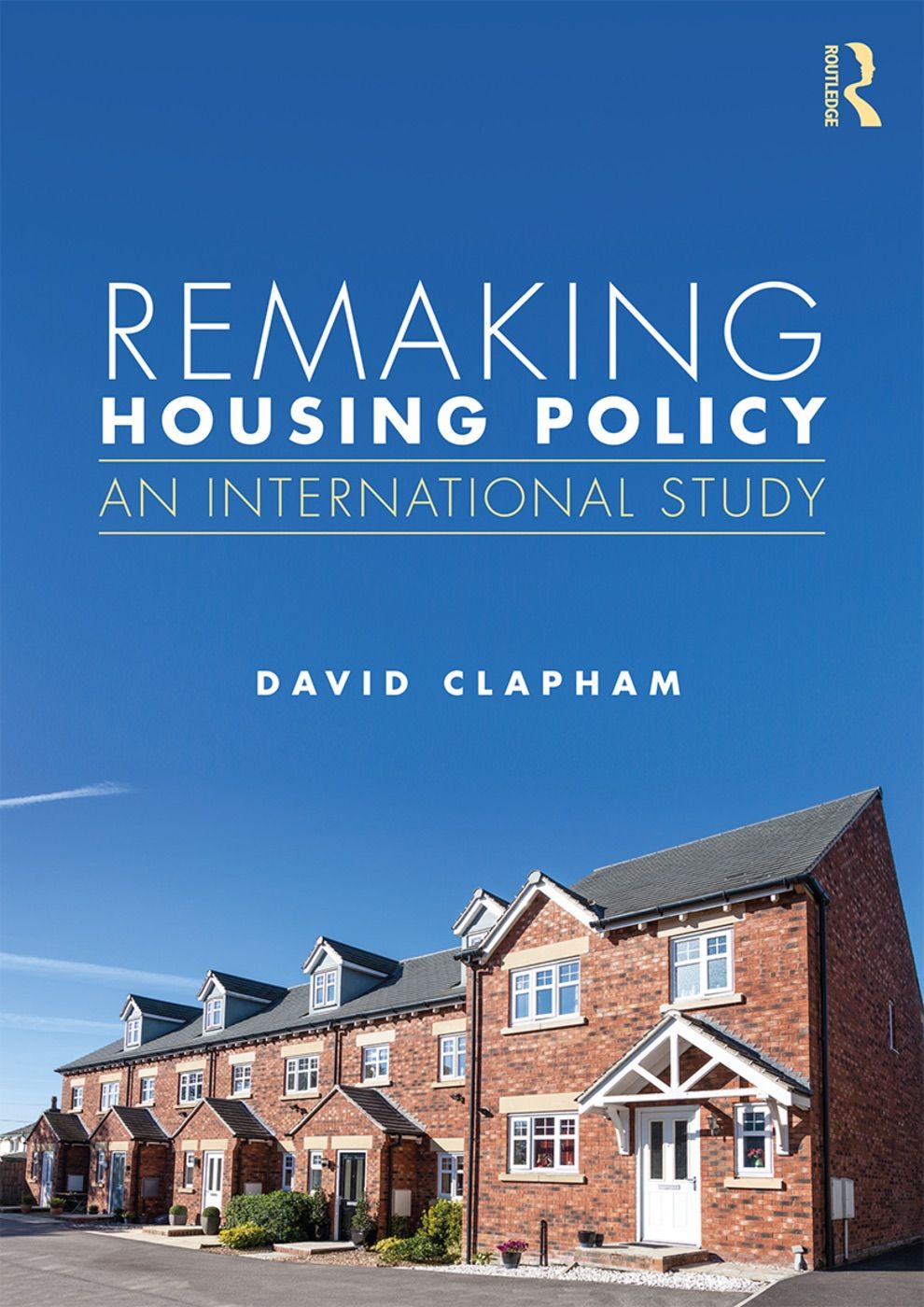
www.buildingsandcities.org/insights/reviews/remaking-housing-policy.html
Remaking Housing Policy: An International Study
By David Clapham. Routledge, 2019, ISBN: 9781138193956
 Elanor Warwick reviews this book which critiques
neoliberal approaches to housing and provides alternative, emergent ideas for
housing policy. With her background in academic, local government and public
sector built environment research (Commission for Built Environment - CABE), Elanor
currently leads the research and policy team for Clarion Housing Association,
UK.
Elanor Warwick reviews this book which critiques
neoliberal approaches to housing and provides alternative, emergent ideas for
housing policy. With her background in academic, local government and public
sector built environment research (Commission for Built Environment - CABE), Elanor
currently leads the research and policy team for Clarion Housing Association,
UK.
In a recent blog David Clapham asks whether housing academics can remain as "neutral observers" providing value-free insight to be used as levers to shift political and popular opinion.
Clapham's new book asks what better housing policy might look like. He sets out to suggest alternatives to current dominant neoliberal views, exploring housing policy founded on improving the welfare of the individual. This is based on four undisputable principles; housing as a right, increased wellbeing, equity and sustainability. The result is an even-handed (but clearly not neutral) meta-review of international housing policy. He highlights common bleak outcomes; rentier-owned under-regulated homes with high rents, house price appreciation, ineffectual deregulation and competition between housing providers, all leading to housing shortages, growing incomes and wealth disparity, inequality and reduced well-being.
Housing academics / activists tend to emphasise distinct positions to strengthen their arguments and it is instructive to read Danny Dorling's or Anna Minton's fiery polemic reduced to a dispassionate half page on the redistribution of housing or the fight for the Heygate. This calm, objective tone, is similar to Clapham's earlier insightful book The Meaning of Housing: A Pathways Approach(Clapham, 2005) which Remaking Housing Policy updates and compliments. Both contain reminders that homes are emotionally charged objects, that residents aren't passive receivers of housing interventions but interact with policy via their individual struggles and household choices, dictated by context and agency.
The breadth of topics covered in the book (from housing justice to housing as a positional good, i.e. the timing of becoming a homeowner matters as it influences how much a household gains - recent home owners will benefit less than baby boomers) makes it an excellent overview for students or professionals. It explains pertinent concepts such as "affordance"; that homes have multiple social and cultural meanings, in addition to their practical utility providing shelter and security. The text is brisk as so much is covered: housing quality, homes as a commodity, or why the market doesn't behave in the ways neoclassical economists might like. This can lead to generalisations. All of the heated arguments underpinning the Nationally Defined Space Standard (extensively described in Park, 2017) are summarised in the line "the impact of space standards is contested" (p. 72). Insights such as this, or that the UK experience of using Section 106 planning conditions to provide social housing has delivered "real benefits in terms of reduced stigma" (p. 157) deserve further explanation (see Burgess, G, Monk, S. & Whitehead (2011) on the mechanisms of Section 106 or Markovich, (2015) on the stigma associated with mixed tenure housing). However, the pithy case studies are a strength. While it is unsettling to read the intense debate about the Grenfell Fire reduced to a handful of bullet points on trade-offs and competing regulatory interests (case study 5.3), it is refreshing to see the case for government intervention in secondary mortgage markets post 2008 distilled to a single page (case study 4.4).
For the last decade English Housing Policy has been in a state of constant flux, meaning some sections of the book will date better than others. Some of the actions called for in the homelessness chapter have already been enacted by the 2018 Homelessness Reduction Act. Chapter Three neatly summarises alternative housing regimes into a table of the pseudo similarities, welfare ideologies and institutional structures of the six countries cited (UK, USA, Sweden, China, Australia and Argentina). This is not a comparative urbanism study crammed with data and tables, and these countries are selectively used to illustrate different housing mechanisms, leaving the messy practicalities of policy transfer between countries (McCann & Ward, 2011) untouched. Chapter Eleven makes the important point that social housing practices are not sufficiently considered within sustainability policy, limiting housing's definition to "utilitarian concepts lacking moral and ethical dimensions" (p. 22). Yet for a book arguing that the two most significant challenges to housing policy are inequality and sustainability, the chapter on environmental sustainability might reflect on current convergence of intuitional and popular environmental movements with Extinction Rebellion and Committee on Climate Change (2019) taking similarly ethical stances
Anyone involved in housing policy will recognise how evidence-based policy has been displaced by rehashed, vote-chasing concepts and impulsive back-of-envelope policy formation. The recent re-emergence of rent to buy (masquerading as right to shared ownership) echoes Jamie Peck's (2010) narrative of "zombie neoliberalism". Peck argues, post the Global Financial Crash, that neo-liberalism is "dead but dominant", its policy reflexes continuing to twitch, surviving only through increasingly interventionist statecraft. Clapham's book usefully counters this forgetful policy formation with thorough historical case studies. Everyone concerned about social housing's future should read the decline of Sweden's housing success stories. Approaches such as soft rent controls (case study 8.4), residential sustainability (case study 11.2), right to shelter and municipal housing companies underpinned the shared belief in public housing for everyone (case study 9.3). However, after the removal of public sector rent benchmarking (case study 4.2) public and private rents diverged rapidly. Clapham argues it was the introduction of these neoliberal policy measures (interest subsidies, property taxation favouring homeowners and reduced housing allowances) that shifted Sweden from tenure neutrality to owner occupancy as favoured tenure (case study 8.5).
The range of neoliberal policies that Clapham catalogues all tend towards privatisation, marketisation, commodification, financialisation and, underpinning all of these trends, the individualisation of a housing unit rather than seeing homes as collectively valued community assets. The book works backwards from the final chapter, which starts to explore alternative regimes offering hope, for example Community Land Trusts. The challenge to address is clearly articulated, yet the proposed tools to make this change, the "language games", "discourse", "coalition building", even the "battle of ideas", seem too weak to overcome the strong vested interests the preceding eleven chapters describe. As Clapham acknowledges, escaping the dominant straightjacket of neoliberal thought is hard, especially when hampered by academic commitments to observational neutrality. Clapham sees limited prospects in existing policy mechanisms, noting that "various attempts to deal with the problems have made things worse" (p. 202). But he is optimistic that now is the time for change and if his alternative ideal housing policy isn't quite formulated yet, Clapham's lucid explanation goes a long way to ensure that emergent new ideas don't make the same mistakes as the past.
References
Burgess, G, Monk, S. & Whitehead, C. (2011). Delivering local infrastructure and affordable housing through the planning system: the future of planning obligations through Section 106 People, Place and Policy, 5 (1), 1-11
Clapham, D. (2005) The meaning of housing: A pathways approach. Bristol: University Press. https://policy.bristoluniversitypress.co.uk/the-meaning-of-housing
Committee on Climate Change (2019) UK housing: Fit for the future? https://www.theccc.org.uk/publication/uk-housing-fit-for-the-future/
Markovich, J. (2015) 'They Seem to Divide Us': Social Mix and Inclusion in Two Traditional Urbanist Communities, Housing Studies, 30:1, 139-168.
McCann, E. & Ward, K. eds. (2011). Mobile urbanism: Cities & policy-making in the global age. Minnesota.
Peck, J. (2010). Zombie neoliberalism and the ambidextrous state. Theoretical Criminology, 14(1), 104-110.
Latest Peer-Reviewed Journal Content
A framework for 1.5°C-aligned GHG budgets in architecture
G Betti, I Spaar, D Bachmann, A Jerosch-Herold, E Kühner, R Yang, K Avhad & S Sinning
Net zero retrofit of the building stock [editorial]
D Godoy-Shimizu & P Steadman
Co-learning in living labs: nurturing civic agency and resilience
A Belfield
The importance of multi-roles and code-switching in living labs
H Noller & A Tarik
Researchers’ shifting roles in living labs for knowledge co-production
C-C Dobre & G Faldi
Increasing civic resilience in urban living labs: city authorities’ roles
E Alatalo, M Laine & M Kyrönviita
Co-curation as civic practice in community engagement
Z Li, M Sunikka-Blank, R Purohit & F Samuel
Preserving buildings: emission reductions from circular economy strategies in Austria
N Alaux, V Kulmer, J Vogel & A Passer
Urban living labs: relationality between institutions and local circularity
P Palo, M Adelfio, J Lundin & E Brandão
Living labs: epistemic modelling, temporariness and land value
J Clossick, T Khonsari & U Steven
Co-creating interventions to prevent mosquito-borne disease transmission in hospitals
O Sloan Wood, E Lupenza, D M Agnello, J B Knudsen, M Msellem, K L Schiøler & F Saleh
Circularity at the neighbourhood scale: co-creative living lab lessons
J Honsa, A Versele, T Van de Kerckhove & C Piccardo
Positive energy districts and energy communities: how living labs create value
E Malakhatka, O Shafqat, A Sandoff & L Thuvander
Built environment governance and professionalism: the end of laissez-faire (again)
S Foxell
Co-creating justice in housing energy transitions through energy living labs
D Ricci, C Leiwakabessy, S van Wieringen, P de Koning & T Konstantinou
HVAC characterisation of existing Canadian buildings for decarbonisation retrofit identification
J Adebisi & J J McArthur
Simulation and the building performance gap [editorial]
M Donn
Developing criteria for effective building-sector commitments in nationally determined contributions
P Graham, K McFarlane & M Taheri
Reimagining circularity: actions for optimising the use of existing buildings
R Lundgren, R Kyrö, S Toivonen & L Tähtinen
Effective interdisciplinary stakeholder engagement in net zero building design
S Vakeva-Baird, F Tahmasebi, JJ Williams & D Mumovic
Metrics for building component disassembly potential: a practical framework
H Järvelä, A Lehto, T Pirilä & M Kuittinen
The unfitness of dwellings: why spatial and conceptual boundaries matter
E Nisonen, D Milián Bernal & S Pelsmakers
Environmental variables and air quality: implications for planning and public health
H Itzhak-Ben-Shalom, T Saroglou, V Multanen, A Vanunu, A Karnieli, D Katoshevski, N Davidovitch & I A Meir
Exploring diverse drivers behind hybrid heating solutions
S Kilpeläinen, S Pelsmakers, R Castaño-Rosa & M-S Miettinen
Urban rooms and the expanded ecology of urban living labs
E Akbil & C Butterworth
Living with extreme heat: perceptions and experiences
L King & C Demski
A systemic decision-making model for energy retrofits
C Schünemann, M Dshemuchadse & S Scherbaum
Modelling site-specific outdoor temperature for buildings in urban environments
K Cebrat, J Narożny, M Baborska-Narożny & M Smektała
Understanding shading through home-use experience, measurement and modelling
M Baborska-Narożny, K Bandurski, & M Grudzińska
Building performance simulation for sensemaking in architectural pedagogy
M Bohm
Beyond the building: governance challenges in social housing retrofit
H Charles
Heat stress in social housing districts: tree cover–built form interaction
C Lopez-Ordoñez, E Garcia-Nevado, H Coch & M Morganti
An observational analysis of shade-related pedestrian activity
M Levenson, D Pearlmutter & O Aleksandrowicz
Learning to sail a building: a people-first approach to retrofit
B Bordass, R Pender, K Steele & A Graham
Market transformations: gas conversion as a blueprint for net zero retrofit
A Gillich
Resistance against zero-emission neighbourhood infrastructuring: key lessons from Norway
T Berker & R Woods
Megatrends and weak signals shaping future real estate
S Toivonen
A strategic niche management framework to scale deep energy retrofits
T H King & M Jemtrud
Generative AI: reconfiguring supervision and doctoral research
P Boyd & D Harding
Exploring interactions between shading and view using visual difference prediction
S Wasilewski & M Andersen
How urban green infrastructure contributes to carbon neutrality [briefing note]
R Hautamäki, L Kulmala, M Ariluoma & L Järvi
Implementing and operating net zero buildings in South Africa
R Terblanche, C May & J Steward
Quantifying inter-dwelling air exchanges during fan pressurisation tests
D Glew, F Thomas, D Miles-Shenton & J Parker
Western Asian and Northern African residential building stocks: archetype analysis
S Akin, A Eghbali, C Nwagwu & E Hertwich
Join Our Community

The most important part of any journal is our people – readers, authors, reviewers, editorial board members and editors. You are cordially invited to join our community by joining our mailing list. We send out occasional emails about the journal – calls for papers, special issues, events and more.
We will not share your email with third parties. Read more



Latest Commentaries
COP30 Report
Matti Kuittinen (Aalto University) reflects on his experience of attending the 2025 UN Conference of the Parties in Belém, Brazil. The roadmaps and commitments failed to deliver the objectives of the 2025 Paris Agreement. However, 2 countries - Japan and Senegal - announced they are creating roadmaps to decarbonise their buildings. An international group of government ministers put housing on the agenda - specifying the need for reduced carbon and energy use along with affordability, quality and climate resilience.
Building-Related Research: New Context, New Challenges
Raymond J. Cole (University of British Columbia) reflects on the key challenges raised in the 34 commissioned essays for Buildings & Cities 5th anniversary. Not only are key research issues identified, but the consequences of changing contexts for conducting research and tailoring its influence on society are highlighted as key areas of action.